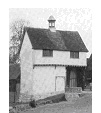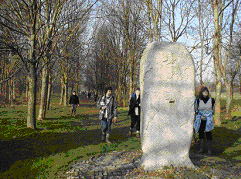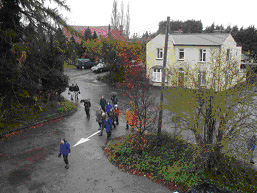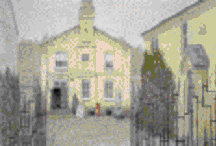** Please note that this is an archive of the CANTAB publication and contains out-of-date information **
CANTAB RAMBLER
Editorial
Most of us when visiting an unfamiliar area use not only maps, but seek inspiration from guidebooks and magazines. As a reader of “Country Walking” over some 10 years, I have always admired the pull-out supplement of regional walks. And I have particularly appreciated the many walks in Cambridgeshire and Norfolk contributed by Jack & Sheila French of Peterborough. Whilst I might have been familiar with the routes in South and East Cambridgeshire, those in Norfolk were a treasure-trove to us. Sadly, after no less than 174 walks, Jack tells us that they will not be offering any more, partly because it becomes increasingly difficult not inadvertently to use walks already described elsewhere, but mostly because they do not want to drive to the other side of Norfolk and back in a day, to cover the county fully.
But the existing walks descriptions remain, treasured in files on many a bookcase, a continuing library of ideas for new excursions, and a reminder of happy days spent rambling.
I am delighted to have persuaded this charming, modest couple to give us their history, and the history of how the walks were derived.
Thank you Jack & Sheila for giving so much pleasure, and may you continue to enjoy many happy rambles yourselves.
Country Walking – Down Your Way
By Jack French
Hopefully Cantab Ramblers will have read and enjoyed some of our 174 contributions in Country Walking magazine. We have tried to find something new and well worth walking but in Cambridgeshire that is often difficult. Our writing started after reading early editions. (CW started as a “taster” in Sept. 1986 then went on sale bi-monthly from April/May 1987 priced £1.10). I thought that I could put together better walks than some of those provided. As it was published here in Peterborough I went to see the Editor with one of my proposals. His reaction was that my hand drawn map was ideal, wishing other contributors paid so much attention to detail, and he would use it in the Down Your Way. We then didn’t stop submitting until probably the last one in Ringstead, Norfolk published in May 2003. The Editors do have one more from Gayton Thorpe to Gayton then through the swamp at East Walton, it may not be used as it is rather adventurous and difficult to follow. If it had been known how dry this last summer was to be it would have been quite acceptable & different, so it may be reconsidered in 2004.
My wife Sheila has always accompanied me so when pictures were required in August 1992, one of her hobbies being photography, the pictures became her responsibility in addition to doing the typing.
First of all the editor accepted anything we provided and we travelled as far as Calderdale, Derbyshire and Leicestershire. Then in 1992 the Editor split the country up between the contributors and we were given Cambridgeshire and Norfolk. We were disappointed as had already prepared a Rutland walk and others were planned. Our thinking is that Cambridgeshire is generally very limited for new good walks: where suitable they are all well covered by other books and leaflets; also in wet weather we tend to avoid them due to the sticky clay. On return from Norfolk our boots seldom need much cleaning, otherwise why do I favour it?
I was reared in Wisbech St Mary at the local garage, from 11 years my brother and I cycled three windswept miles each way to Wisbech Grammar School sometimes returning again in the evening to Army cadets etc. Winter life was a continuous round of colds for me, conditions being much worse than today as the water table was almost at ground level and everywhere was so damp. Older folks think that the area is now over drained, but that is digressing. We had uncles farming in Norfolk whom we visited and I always thought the countryside was lovely, with its large hedges, woods and no mud, that’s the place for me I thought! Later, when grown up and in the RAF, as soon as I set out from Peterborough my thinking was I’m never coming back here.
But it was not to be, my father died in 1952 and I was released to help my mother to continue the business, just when I had decided to make the RAF and aeroplanes my future. After a few years we sold up with the intention of me continuing in the RAF, but things had moved on and we had a family to consider. I took a temporary job at Perkins Diesel and stayed for 30 years as a draughtsman/engineer. During this time I took up several hobbies, poultry and beekeeping, sailing and golf, but always enjoyed walking and was on the committee of the HF Rambling Club, Sheila being the treasurer for 8 years. We ran coaches and weekends away and the club prospered on a ‘sub’ of £1, programmes being given out on rambles and mainly hand delivered. From these walks we began to appreciate Norfolk even more but haven’t moved house as our two daughters and grandchildren live nearby and give us lots of pleasure We found that I could afford to take early retirement from what was becoming a very stressful job,and in so doing I could pursue my hobby and do a very rewarding job, as walks leader for CHA at Cromer. It turned out to be some of the happiest times of my life assisting so many people to really enjoy their holiday, many being very surprised at the variety of Norfolk’s landscape.
Favourite Walks…
We’re asked where is your favourite walk here? Mine is Cromer to Overstrand: check the tides and go one way on the beach and the other along the cliff top. For an extension go up the road by the car park/toilets, left on a path up and past the old station to Northrepps then up and loop down back on the path east of the aerials to the coast road. One may now have to go back into Overstrand via the road, the cliff top path now being too dangerous.
Sheila prefers the one from Sheringham west on the cliff to Weybourne. A short walk can be had by earlier cutting inland to Sheringham Park, otherwise continue until the cliff finishes and take the track inland to the road, left and right up the track to cross the railway then left to Weybourne station. Leave by the station footbridge to carry on through Sheringham Park to Upper Sheringham then on to a track to the main Sheringham entry road and back to the start.
In Cambridgehire, we think the best is on our doorstep with a selection starting in Ferry Meadows. King’s Lynn ramblers have been by coach three times and been pleasantly surprised at how much they had enjoyed their visits. The last one for example was first go to the entrance to see the wonderfully carved elm tree sculpture, which is not to be missed, then west along the north side of the railway, over the bridge and west along a lovely track, once part of a Milton estate toll road running from the A47 picturesque bridge to Alwalton. At the fence, the old track is blocked off, go down to the riverside then up from an old bathing area, take the first road right back down to the river, left over the backwater and lock, over the water meadow, footbridge and left to Castor water mill. Then either go up the lane and right at the railway bridge for a 4 mile walk or go left beside the garden on Nene Way to take the right stile towards Castor. At the railway bridge one can go right on the start of a cycleway leading back or go under the bridge and into Castor. To return take the path starting east of the church, cross the next lane to take a path curving right to exit on to the main road. Turn left to go first right on the old A47 to Ferry Bridge and back into the park. (8 miles).
JF & SF
Topical Notes…
Healthy Walks
Stan Hampton, following his recovery from heart bypass surgery, has been pleased to lead a “Walking for Health” group from St Ives every Tuesday and Thursday, for distances of up to 4 miles. The aim is primarily to encourage new walkers, but the short walks are also being found attractive by seasoned ramblers who, for one reason or another, are not currently able to take part in the longer walks on the Ramblers’ Assoc. programme.
For more info: phone 01480 466558.
Feet to come first?
Lisa Woodburn draws our attention to a Times article of 26 October by Jonathan Leake.
Under a new plan to promote walking, local councils will have the option to rephase traffic lights and Puffin & Zebra pedestrian crossings to give priority to walkers in urban areas. Studies by the Dept. of Transport have shown that the longer the wait for lights to turn in favour of those on foot (currently up to 2 mins.) the higher is the rate of traffic accidents.
However, such plans will only apply to urban situations, and don’t get too excited, as the Government’s Walking Strategy has an incubation period of about 6 years…..
The Chiltern Way
The Chiltern Way was originally designed as a circular route of 125 miles as the Chiltern Society’s Millennium Project. More recently, a further 27 miles have been added to the North, and 31 miles to the South, including yet more beautiful scenery in Hertfordshire, Buckinghamshire, Bedfordshire and South Oxford. A new guidebook, showing the old route and new extensions, “The Chiltern Way” was published in October 2003, when the new extensions were formally launched. Written by Nick Moon, the guidebook is published by Book Castle at £9.99, and is obtainable from bookshops and from the Chiltern Society Office: Freepost (HH601) Chesham, Bucks HP5 1ZA. Tel. 01494 771250 e-mail: office@chilternsociety.org.uk
Icknield Way Association 20 years on
I recently had the pleasure of attending the 19th AGM of the IWA, held this year at Dalham, Suffolk. Thus, counting the inaugural meeting, the Society finds itself 20 years on. In many ways, its achievements are very solid. A route exists between Ivinghoe Beacon and Knettishall Heath, which is waymarked throughout, and supported by all the County Councils along the route. The guidebook has never been out of print since the early days (when, as then a member of the committee, I drew the first, amateur maps). Parts of the route have been much improved by creating new rights of way, or bringing neglected paths back into use. In more recent years, an additional alternative route has been promoted, and signed for horse-riders and cyclists. Several circular walks based on the Icknield Way have been promoted.
Yet in one respect the Society has yet to achieve its aim, to have the Icknield Way designated as a National Trail. It remains the missing link between the Peddars Way and The Ridgeway, both of which have the coveted acorn waymarks of a Countryside Agency supported route.
Most readers will have walked part or all of this fine path. What can we do to continue to push for its greater status (and hence maintenance, free from the constraints of County Council budgets) ? Firstly, we could consider joining the Association, whose membership has become fairly static over the last few years. We could write to the Countryside Agency with our views. We could even consider joining the committee, or acting as a warden, to look after a section of the route. Twenty years ago the prime-movers, Thurstan Shaw, Ken Payne and others, were in their sixties, and now, in their eighties, much-loved and resting upon their labours. Others were then around 40, and making time for this and other involvements in a busy working life. But now these are themselves in their sixties, and they find there is no-one following on behind, in spite of the popularity of the route.
For more info: Chris James, Secretary,
56 Back St., Ashwell, Baldock SG7 5PE
Tel. 01462 742684;
e-mail chrisjames56@btinternet.com
Newmarket Ramblers go online
Suffolk RA Area Committee has purchased website names for all its local groups. Newmarket’s site will be going live shortly, at the address: www.newmarketramblers.org.uk There will be details of most group walks but not of social events.
September in Swaledale…
Ten ramblers, most from the Cambridge area, enjoyed a delightful midweek walking break in mid-September, led by David & Viv Elsom. They were accompanied by their indefatigable 12 year old sheepdog, Nell, always on the lead, and in the lead! We were based on the comfortable Kearton Country Hotel situated well up the dale at Thwaite, and ideally placed for walks at Kisdon Hill at the top of the dale, and for seeing the site of old lead-mines above Swinner Gill. David & Viv seem to know every track in this area, so following a tiny sheep-run above waterfalls led us (fairly) easily up steep terrain, whose photograph, when viewed later, made it seem impossible that we had reached the top! Lower down the dale, Gunnerside and Muker offer shops, tea-rooms, and a museum for the less energetic. One day, we drove to Hawes, to spend an hour being seduced by bargains in the lively market, before walking over the moors to Bainbridge. Another day we drove to Reeth, to enjoy a walk along Fremington Edge, and take our picnic lunch near the village of Booze!
On a final half-day David organised a short circuit from the village of Marrick, while three of our number investigated the potential of the nearby golf course.
Measuring the walks as in the 12 mile bracket fails to take note of a salient feature of this delightful area. Not only are there much-photographed stone barns scattered across the hillsides, the numerous small fields are divided by tall stone walls. Paths cross these by squeeze-stiles or stone step stiles. On one of the walks, we counted 86 of these picturesque impediments, surely equivalent to another couple of miles in the day, and needing a second helping of pudding in the evening to restore us!
Metal, Concrete, Wood or Plastic?
What am I talking about? Why, signposts, of course.
There has been a rather intriguing discussion on Ramblersnet prompted by John Andrews starting a discussion on the best mode of construction. He concludes:…
‘I have long had the feeling that different types of signposts have varying effects on the users of rights of way and on landowners. Wooden ones seem, by their inconspicuous and often “wobbly” character, to be timid and self-effacing. I imagine them wispering “Excuse me; sorry to bother you. I hope you don’t mind me mentioning it, but did you realise there’s a footpath along here?” Path users rather worried about how much confidence to be taken from this somewhat uncertain proclamation; landowners scarcely pause for thought before elbowing them out of the way!
Concrete monsters, by contrast are over-bearing and town-crier like in their boasts. “You’d better believe this is a public right of way! Ignore me at your peril! Users a little overawed at their presumption. Landowners, incensed at such arrogance, rush for the nearest JCB.
Perhaps the quietly confident green variety strike the right psychological chord. No doubt somebody will tell me …..’
John Andrews
Cantab Rambler by E-Mail & Post
A large number of you now receive Cantab by e-mail. By hand, 10p is appreciated towards the cost of paper and ink. If you would like to receive an issue by post, please send a large SAE, and a 10p stamp.
Offers of brief articles will be gratefully received.
This is a privately produced magazine, and the views expressed are solely those of the editor, or of the author of an individual item. Janet Moreton 01223 356889
e-mail roger.janet@care4free.net
Price 10 pence where sold
© Janet Moreton, 2003.








